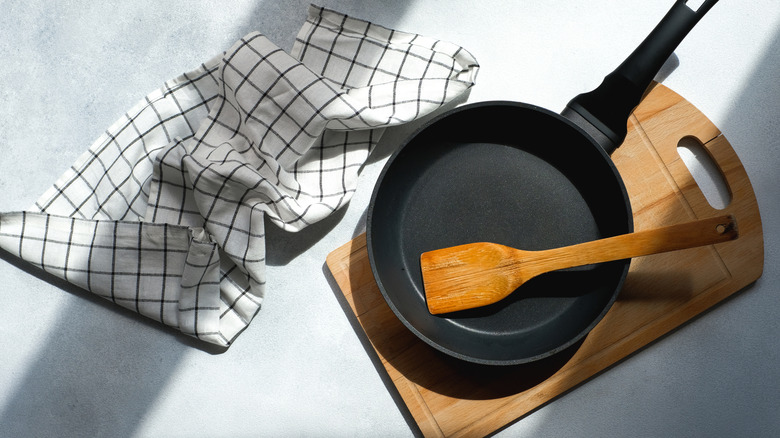One Simple Mistake Is Causing Food To Stick To Your Pans
Learning to cook on a cast iron or stainless steel pan can be a bit daunting. These days, cast iron pans have an almost mythological aura around them, with thousands of Reddit posts with comments also numbering in the thousands about how to use and care for them. Stainless steel seems a bit more straightforward: they're lighter and heat up fast. But heaven help you during your first attempt at making scrambled eggs in a stainless steel pan — or a cast iron for that matter. Try as you might, somehow your food just fuses to the pan like glue. There might be several reasons for this sticky situation, but the most likely culprit is actually one simple thing: failure to preheat your pan.
I don't mean set your cast iron pan on a burner running on high and walk away until it's smoking. (Actually don't walk away at all while you're cooking!) You'll actually find that the best way to preheat a pan is to use medium to medium-low heat, and let it sit for maybe about five minutes. For a big hulking cast iron, you might need upwards of 10-15 minutes.
Bringing your pan up to heat gently is key here, since a pan that's too hot can just burn or char the outside and will also cause the food to stick. Since you probably don't have a fancy, infrared surface temperature thermometer, the easiest way to tell when your pan is hot enough is to flick some water in there. If it sizzles and evaporates, you're ready to start cooking!
Make sure you also use enough oil
Preheating your cast iron or stainless steel pan is absolutely crucial for getting the perfect Maillard reaction, which is a process that describes how foods brown and cook evenly in the presence of heat. But for both stainless steel and cast iron cookware, having a hot pan isn't enough. You really do need oil when cooking. And while many of us are still terrified of cooking fats (thanks, 1990s diet fads!), they are essential for creating a natural, non-stick surface.
For cast iron — and carbon steel for that matter — oils are essential for creating a non-stick surface on your pans, which are not as smooth as you may think. If you were able to zoom in on your pans' surfaces, you'd see all sorts of bumps and ridges. This is a big reason why these pans are famed for their food-fusing abilities. Basically, cooking oils fill out these crevices and ridges, polymerizing to the pan as they heat, which basically means the fats change from liquid to a hardened surface that's actually quite slick. (This also keeps out oxygen and moisture, preventing your pan from rusting.)
For stainless steel pans, oil creates the perfect barrier between your food and the cooking surface. You also might want to preheat your stainless steel pan before adding oil, but it probably won't ruin your food either way. For stainless steel pans, the essential thing is not to not flip or move the food until it's released from the cooking surface, meaning it's easy to move the food around! Trying to flip or stir too early will result in disaster.

